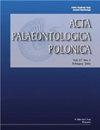New material of the trechnotherian mammal Lactodens from the Early Cretaceous Jehol Biota: comparison with Origolestes and implications for mammal evolution
IF 1.9
3区 地球科学
Q2 PALEONTOLOGY
引用次数: 0
Abstract
New material of the trechnotherian mammal Lactodens from the Early Cretaceous Jehol Biota: Comparison with Origolestes and implications for mammal evolution. Acta Palaeontologica Polonica 67 (1): 135–153. A new specimen of Lactodens sheni , the only known spalacolestine from the Early Cretaceous Jehol Biota, is reported from the Jiufotang Formation, Liaoning, China. The description focuses on the dental and mandibular morphologies from both the new specimen and the holotype, particularly those that were unknown or poorly known from the holotype when the taxon was established. As revealed primarily by high-resolution computed tomography, morphologies and size gradient of the lower molars and detailed features of the mandibles, such as the masseteric foramen, can be unequivo-cally described. The dental and mandibular morphologies of Lactodens are compared with those of Origolestes lii , also from the Jehol Biota; these two taxa represent by far the best specimens in Spalacotheriidae and Zhangheotheriidae, respectively, and could be used as the representatives of their own groups in future higher-level phylogenetic analysis of mammals. The two taxa display considerable differences in dental and mandibular features, probably indicating a deeper split of spalacotheriids and zhangheotheriids than previously thought. Absence of the Meckelian groove in Lactodens , contrasting to the distinct one that holds a sizable Meckel’s cartilage in adult Origolestes , suggests an independent evolution of the definitive mammalian middle ear within “symmetrodontans”. The morphological gradient in the tooth row and association of the upper and lower dentitions from the same individual animal are also instructive for interpreting molar variations and evolution in “symmetrodontans” and早白垩世热河生物群中乳齿动物的新材料:与Origolestes的比较及其对哺乳动物进化的启示
早白垩世热河生物群中乳齿动物的新材料:与Origolestes的比较及其对哺乳动物进化的启示。古生物学报67(1):135-153。报道了辽宁九佛堂组中唯一已知的早白垩世热河生物群空间溶洞石(Lactodens sheni)新标本。描述的重点是来自新标本和原型的牙齿和下颌形态,特别是那些在该分类群建立时未知或对原型知之甚少的形态。主要通过高分辨率计算机断层扫描显示,下磨牙的形态和大小梯度以及下颌骨的详细特征,如咬肌孔,可以明确地描述。将乳齿动物的牙齿和下颌形态与同样来自热河生物群的Origolestes lii进行了比较;这两个类群分别代表了迄今为止在Spalacotheriidae和Zhangheotheriidae中最好的标本,可以作为未来更高层次哺乳动物系统发育分析中各自类群的代表。这两个分类群在牙齿和下颌特征上显示出相当大的差异,可能表明空间异齿类和掌异齿类的分裂比以前认为的要深。乳齿动物中没有梅克尔沟,与成年Origolestes中有一个明显的梅克尔软骨形成鲜明对比,表明哺乳动物中耳在“对称齿兽”中是独立进化的。同一动物牙列的形态梯度和上下牙列的联系也有助于解释“对称齿兽”和“对称齿兽”的磨牙变异和进化
本文章由计算机程序翻译,如有差异,请以英文原文为准。
求助全文
约1分钟内获得全文
求助全文
来源期刊

Acta Palaeontologica Polonica
地学-古生物学
CiteScore
2.80
自引率
5.60%
发文量
36
审稿时长
12.5 months
期刊介绍:
Acta Palaeontologica Polonica is an international quarterly journal publishing papers of general interest from all areas of paleontology. Since its founding by Roman Kozłowski in 1956, various currents of modern paleontology have been represented in the contents of the journal, especially those rooted in biologically oriented paleontology, an area he helped establish.
In-depth studies of all kinds of fossils, of the mode of life of ancient organisms and structure of their skeletons are welcome, as those offering stratigraphically ordered evidence of evolution. Work on vertebrates and applications of fossil evidence to developmental studies, both ontogeny and astogeny of clonal organisms, have a long tradition in our journal. Evolution of the biosphere and its ecosystems, as inferred from geochemical evidence, has also been the focus of studies published in the journal.
 求助内容:
求助内容: 应助结果提醒方式:
应助结果提醒方式:


